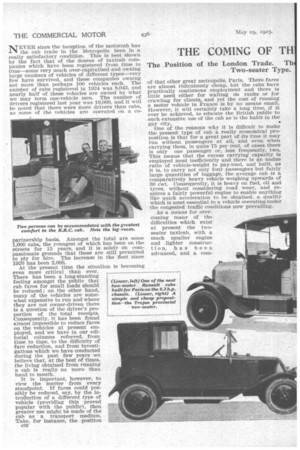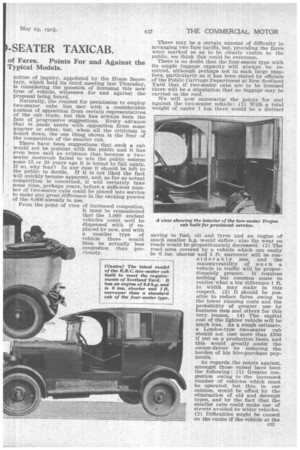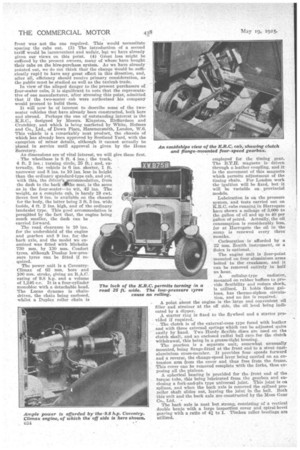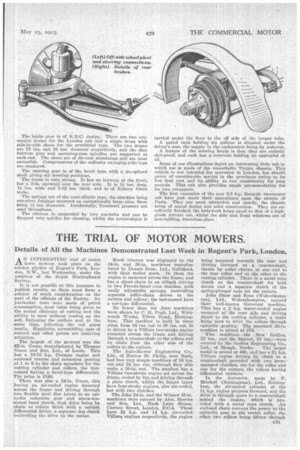THE COMING OF TH -SEATER TAXICAB.
Page 16

Page 17

Page 18

Page 19

If you've noticed an error in this article please click here to report it so we can fix it.
The Position of the London Trade. Th Two-seater Type.
of Fares. Points For and Against the Typical Models. NEVER since the inception of the motorcab has the cab trade in the Metropolis been in a really satisfactory condition. This is best shown by the fact that of the dozens of taxicab companies which have been registered from time to time—some very much over-capitalized and owning large numbers of vehicles of different types—very few have survived, and these companies owning not more than perhaps 100 vehicles 'each. The number of cabs registered in 1924 was 8,043, and nearly half of these vehicles are owned by what we may term one-vehicle men. The number of drivers registered last year was 10,000, and it will be noted that there were more drivers than cabs, as some of the vehicles are operated on a co partnership basis. Amongst the total are some 1,000 cabs, the youngest of which has been on the streets for 15 years, and it is solely on compassionate grounds that these are still permitted to ply for hire. The increase in the fleet since 1920 has been 2,000. At the present time the situation is becoming even more critical than ever.
There has been a long-standing feeling amongst the public that cab fares for small loads should be reduced • on the other hand, many of the vehicles are somewhat expensive to run and where they are not owner-driven there is a question of the driver's proportion of the total receipts. Consequently, it has been found almost impossible to reduce fares on the vehicles at present employed, and we have in our editorial columns referred, from time to time, to the difficulty of fare reduction, and from investigations which we have conducted during the past few years we believe that, at the best of times. the living obtained from running a cab is really no more than hand to mouth.
It is important, however, to view the matter from every standpoint. If fares could possibly be reduced, say, by the introduction of a different type of vehicle (providing this proved popular with the public), then greater use might be made of the cab as a transport medium. Take, for instance, the position c32 of that other great metropolis, Paris. There fares are almost ridiculously cheap, but the cabs have practically continuous employment and there is little need either for waiting on ranks or for crawling for clients, and yet the cost of running a motor vehicle in France is by no means small. However, it will certainly take a long time, if it ever be achieved, to educate the British public to such extensive use of the cab as is the habit in the gay city.
One of the reasons why it is difficult to make the present type of cab a really economical proposition is that for a great part of its time it may run without passengers at all, and even when carrying them, in quite 75 per cent, of cases there is only one passenger or, less frequently, two. This means that the excess carrying capacity is employed most inefficiently and there is an undue ratio of vehicle-weight to pay-load, and built, as it is, to carry not only four passengers but fairly large quantities of luggage, the average cab is a comparatively heavy vehicle weighing upwards of 30 cwt. Consequently, it is heavy on fuel, oil and tyres, without considering road wear, and requires a fairly powerful engine to enable anything like quick acceleration to he obtained, a quality which is mOst essential to a vehicle onerating under the congested traffic conditions now prevailing.
As a means for overcoming many of the difficulties which exist at present the twoseater taxicab, with a much smaller engine and lighter construct i o n, has been advanced, and a corn mittee of inquiry, appointed by the Home Secretary, which held its third meeting last Thursday, is considering the question of licensing this new type of vehicle, witnesses for and against the proposal being heard.
Naturally, the request for permission to employ two-seater cabs has met with a considerable amdunt of opposition from certain representatives of the cab trade, but this has always been the Late of progressive suggestions. Every advance that is made meets with opposition from some quarter or other, but, when all the criticism is boiled down, the one thing shown is the fear of the competition of the smaller cab.
There have been suggestions that such a cab would not be popular with the public and it has even been said as evidence that because a twoseater motorcab failed to win the public esteem some 15 or 20 years ago it is bound to fail again'. If so, why fear? In any case it should be left to the public to decide. If it is not liked the fact will quickly become apparent, and, so far as actual competition is concerned, it will certainly take some time, perhaps years, before a sufficient number of two-seater cabs could be placed into service to make any great difference in the earning powers of the 8,000 already in use.
From the point of view of Increased congestion, it must be remembered that the 1,000 ancient vehicles could well be dispensed with if replaced by new, and with a smaller type of vehicle there would then be actually less congestion than previ ously. There may be a certain amount of difficulty in arranging two fare tariffs, but, providing the fares were marked so as to be clearly visible to the public, we think this could be overcome. There is no doubt that the four-seater type with its ample luggage capacity will always be required, although perhaps not in such large numbers, particularly as it has been stated by officials of the Public Carriage Department at New Scotland Yard that if two-seater cabs are to be licensed there will be a stipulation that no luggage may be carried on the roof.
We will now summarize the points for and against the two-seater vehicle : (I) With a total weight of under 1 ton there would be a distinct saving in fuel, oil and tyres and an engine of much smaller h.p. would suffice ; also the wear on roads would be proportionately decreased. (2) The road area covered by a vehicle which can easily be 6 ins, shorter and 1 ft. narrower will be con siderably less, and the rualiceuvrability of such a vehicle in traffic will be proportionately greater. It requires nothing but common sense to realize what a big difference 1 ft. in width may make in this respect. (3) It should be possible to reduce fares owing to the lower running costs and the probability of greater use by business men and others for this very reason. (4) The capital cost of the lighter vehicle will be much less. As a rough estimate, a London-type two-seater cab should not cost more than £350 if put on a production basis, and this would greatly assist the owner-driver by reducing the burden of his hire-purchase payments.
As regards the points against, amongst those raised have been the following : (1) Oreater congestion owing to the increased number of vehicles which must be operated, but this, in our opinion, would be offset by the elimination of old and decrepit types, and by the fact that the smaller cabs could make use of streets avoided by wider vehicles. (2) Difficulties might be caused on the ranks If the vehicle at the
front was not the one required. This would necessitate spacing the cabs out. (3) The introduction of a second tariff would be inconvenient and unfair, but we have already given our views on this point. (4) Great loss might be suffered by the present owners, many of whom have bought their cabs on the hire-purchase system. As we have already pointed out, we do not think that the change would be sufficiently rapid to have any great effect in this direction, and, 'after all, efficiency should receive primary consideration, as the public must be studied as well as the taxicab trade.
In view of the alleged danger to the present purchasers of four-seater cabs, it is significant to note that the representa tive of one manufacturer, after stressing this point, admitted that if the two-seater • cab were authorized his company would proceed to build them.
It will now be of interest to deseribe some of the twoseater vehicles that have already been ennstructed, both here and abroad. Perhaps the one of outstanding interest is the K.R.C., designed by Messrs. Kingston, Richardson and Crutchley, and which is being marketed by White, Holmes and Co., Ltd., of Down Place, Hammersmith, London, W.6.
This vehicle is a remarkably neat product, the chassis of which has already been approved by Scotland Yard, with the .exception of minor details, although it cannot actually be placed in service until approval is given by the Home
Secretary.
As dimensions are of vital interest, we will give these first. The wheelbase is 8 ft. 4 ins. ; the track, 4 ft. 2 ins.; turning circle, 25 ft.; and, externally, the vehicle is 6 ins. shorter, 1 ft. narrower and 8 ins. to 10 ins, less in height than the ordinary spudard-type cab, and yet, With this, the driver's .accommodation, from
the dash to the back he seat, is the same as in the four-seater---to wit, 42 ins. The weight, as a complete cab, is barely 19 cwt. Seven feet 9 ins, is available on the chassis for the body, the latter being 3 ft. 5 ins, wide inside, 4 ft. 2 ins, high, and of the ordinary landanlet type. This good accommodation is permitted by the fact that, the engine being much smaller, the dash can be carried forward.
The road clearance is 10 ins. for the undershield of the engine and gearbox and 9 ins, for the back axle, and the model we examined was fitted with Michelin 780 mm. by 130 mm. Confort tyres, although Dunlop low-pres„sure tyres can be fitted if required.
The power unit is a CoventryClimax of 63 mm. bore and 100 mm. stroke, giving an R.A.C. rating of 9.8 h.p. and a volume of 1,246 c.c. It is a four-cylinder monobloc with a detachable head. The Lucas dynamo is chaindriven, the chain being enclosed, whilst a Duplex roller chain is employed for the timing gear. The B.T.H. magneto is driven through a leather coupling, and it is the movement of this magneto which permits adjustment of the timing chain. For London work the -ignition will be fixed, but it will be variable on provincial models.
Lubrication is on the pressure system, and tests carried out on K.R.C. cabs running in Harrogate have shown a mileage of 3,000 to the gallon of oil and up to 40 per gallon of petrol. Actually, the oil consumption is considerably less, for at Harrogate the oil in the ,sump is renewed every three months.
Carburation is afforded by a 22 mm. Zenith instrument, or a Solex is optional.
The engine unit is four-point mounted on four aluminium arms bolted to the crankcase, and it can be removed entirely in half an hour.
A cellular-type radiator, mounted on rubber buffers to pro
The lock of the K.R.C. permits turning in a vide flexibility and reduce shock, road 25 ft. wide. The low-pressure lyres is utilized. It holds three gal cause no roiling. Ions, has thermo-siphon circula
tion, and no fan is required. A point about the engine is the large and convenient oil filler and strainer at the off side, the oil level being indi A starter ring is fixed to the flywheel and a starter provided if required. The clutch is of the external-cone type faced with leather and with three external springs which can be adjusted quite easily by hand. Two Hardy flexible discs are used on the clutch shaft, and an enclosed radial ball race for the clutch withdrawal, this being in a grease-tight housing. The gearbox is a separate unit, somewhat unusually mounted, being flange-fitted at the front end to a stout castaluminium cross-member. It provides four speeds forward and a reverse, the change-speed lever being carried on an extension arm from the cover and thus free from the frame. This cover can be removed complete with the forks, thus exposing all the pinions.
A spherical bearing is provided for the front end of the torque tube, this being lubricated from the gearbox and enclosing a fork-and-pin type universal joint. This joint is on splines, and when the back axle is removed the splined propeller shaft slides out, leaving the joint in the ball. Both this unit and the back axle are constructed by the Moss Gear
Co., Ltd. • • The back axle is neat but strong, consisting of a vertical double banjo with a large inspection cover and spiral-bevel gearing with a ratio of 41 to 1. Timken roller bearings are utilized. The brake gear is of K.R.C. design. There are two concentric drums for the London cab and a single drum with side-by-side shoes for the provincial type. The two drums are 12 ins. and 10 ins, diameter respectively, and the shoe fulcrum pins and operating-cam spindles are supported at each end. The shoes are of die-cast aluminium and are most accessible. Compensators of the ordinary swinging-yoke type are employed.
The steering gear is of the bevel type with a six-splined shaft giving six wearing positions.
The frame is very strong. It has no insweep at the front, but a 2-in. upsweep over the rear axle. It is 31 ins, deep, ins, wide and 5-32 ins, thick, and is of Rubery Owen make.
The springs are of the semi-elliptic type, the shackles being one-piece forgings mounted on exceptionally large pins, these being :1* ins, diameter. incidentally, Tecalemit greasers are used throughout.
The silencer is suspended by two eye-bolts and can be dropped very quickly for cleaning, whilst the accumulator is carried under the floor to the off side of the torque tube.
A petrol tank holding six gallons is situated under the driver's seat, the supply to the carburetter being by Autovac.
A feature of the steering heads is that they are entirely dirt-proof, and each has a reservoir holding an eggcupful of oil.
Some of our illustrations depict an interesting little cab in which use is Made of the remarkable Trojan chassis. This vehicle is not intended for operation in London, but should prove of considerable service in the provinces owing to its low first cost and its ability to run consistently for long periods. This cab also provides ample accommodation for its two occupants.
The first examples of the new 8.3 h.p. Renault two-seater cab have just made their appearance upon the streets of Paris. They are most attractive and speedy, the chassis being of sound design and solid construction. They are excellently finished, the bodywork being equal to that of a highgrade private car, whilst the side and front windows are of non-rattling, frameless glass.




























